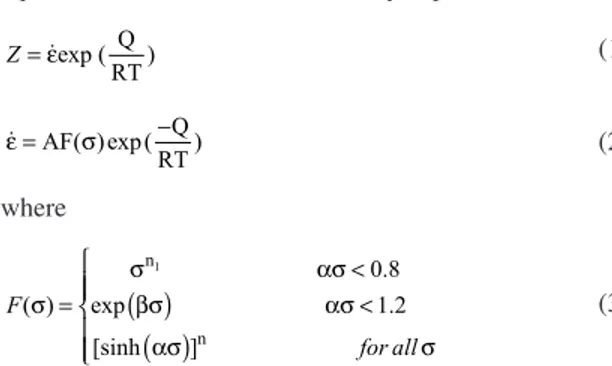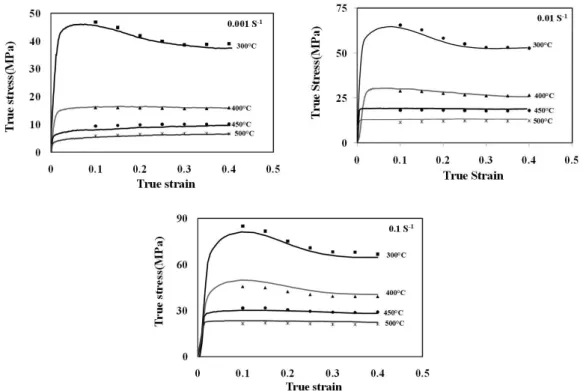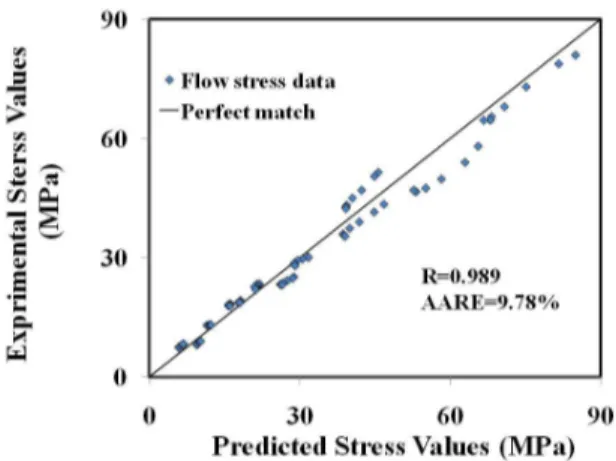*e-mail: s.mirjavadi@ut.ac.ir
Compressive Deformation Behavior Modeling of AZ31 Magnesium Alloy
at Elevated Temperature Considering the Strain Effect
Gh. A. Nourollahia, M. Farahania, A. Babakhanib, S. S. Mirjavadia*
aSchool of Mechanical Engineering, College of Engineering, University of Tehran, Tehran, Iran bCollege of Engineering, University of Tehran, Tehran, Iran
Received: December 23, 2012; Revised: May 29, 2013
The true stress–strain data from isothermal hot compression tests, in the temperature range of 300-500 °C and strain rate of 0.001-0.1s–1, were employed to study the low behavior of AZ31 and to develop constitutive equation based on an Arrhenius-type equation. The low stress increases with the decrease of deformation temperature and the increase of strain rate, which can be represented by Zener–Hollomon parameter in an exponential equation. The inluence of strain was incorporated in the developed constitutive equation by considering the effect of strain on material constants. The results show that the proposed constitutive equations give a precise estimate for high temperature low stress AZ31 alloy, which means it can be used for numerical simulation of hot deformation process and for choosing proper deformation parameter in engineering practice accurately.
Keywords: magnesium alloy, flow behavior, constitutive equations, numerical modeling
1. Introduction
To analyze the hot deformation processes (e.g. forging, rolling and etc.) it is necessary to describe the change in mechanical response under external loadings. This should be conducted in terms of constitutive equations which relate the stress and strain values to the related thermomechanical conditions of temperature and strain rate. In this regard, a number of previous researches have been devoted to assess such equations for conventionally hot worked magnesium alloys. Some have applied a power law equation to describe the relationship between stress and strain rate at low stresses1-5. Others have employed an exponential relationship at high stresses2,6. A phenomenological method was proposed by Sellars and McTegart7 where the low stress is expressed by the hyperbolic laws in an Arrhenius-type equation, has also been applied8,9. Qin et al.10 developed a model to determine the low stress of magnesium alloy during hot deformation. Quan et al.11 predicted a constitutive model for the dynamic recrystallization evolution of AZ80 magnesium alloy based on stress-strain data. However, there are always some limitations for the original constitutive model. So, in order to accurately describe and predict the flow behaviors for the different metals or alloys, considerable amount of works had been done to modify this equation by considering the special effects of the forming processing parameters. Slooff et al.12 have noted that a strain-dependent parameter should be incorporated to correct the constitutive behavior. Some investigations have established the constitutive equations for various metals and alloys such as 9Cr–1Mo (P91) steel13, aluminum alloys14-16, V150 grade oil casing steel17, H62 brass alloy18 incorporating the effect of the strain. However it has not well documented in case of magnesium alloys yet.
The present work deals with developing a proper constitutive based model using hyperbolic sine equations considering the effect of strain. The main objective is to describe the high temperature low behavior of AZ31 alloy, as the most common wrought AZ magnesium alloy series.
2. Experimental Procedure
The experimental material was AZ31 magnesium alloy (Mg–2.9Al–0.85Zn–0.3Mn, wt. %) which was received as-hot rolled plates with 22 mm thickness. The cylindrical hot compression testing specimens were machined in the sizes of Φ 8 × H 12 mm. In all as-rolled specimens the deformation axis was selected to be parallel to the rolling direction. As was well-documented the rolled plates would have a texture with basal plane mainly parallel to normal direction. In the present work the deformation axis of the all specimens is normal to the basal planes. The isothermal hot compression tests were carried out at temperature range of 300-500 °C with initial strain rate of 0.001, 0.01 and 0.1 s–1. The specimens were irst heated up to the deformation temperature and held isothermally for 5 min, prior to straining. The specimens were then compressed to a true strain of 0.4 using an Instron-4208 universal testing machine, equipped with electrical resistance furnace, which can maintain temperature variation of ±5K. This was followed by quenching them in water right after straining.
3. Result and Discussion
3.1.
Flow stress characteristics
to temperature and strain rate, with the peak low stress being shifted to lower stresses and lower strains as the rate of deformation is reduced or the deformation temperature is increased. The related characteristics will be discussed in the following sections.
3.2.
Constitutive equations
As is well established the correlation between the low stress (σ), temperature (T) and strain rate (ε), particularly at high temperatures, can be expressed by an Arrhenius type equation7. Moreover, the effects of temperature and strain rate on deformation behavior may also be represented by the Zener-Holloman parameter (Z) in an exponent type equation19. These are mathematically expressed as:
= εexp ( Q) RT
Z (1)
− ε = AF( ) exp (σ Q)
RT (2)
where
( )
( )
σ ασ <
σ = βσ ασ <
ασ σ
1 n
n
0.8 ( ) exp 1.2
[sinh ]
F
for all
(3)
where R is the universal gas constant (8.314 J mole−1 K−1); T
is the absolute temperature in K; Q is the activation energy
(kJ. mol−1); A, β , n
1,α and n are the materials constants, α = β/n1.
3.3.
Determination of materials constants
True stress-true strain data from the compression tests at various processing conditions were employed to calculate the materials constants of the constitutive equations. The evaluation procedure of material constants at true strain of 0.2 as an example is as follows. For low and high stress levels, substituting the values of F(σ) in Equation 2 gives the following relationships, respectively:
ε = σ
B n1 (4)
ε = βσ
C exp( ) (5)
where B and C are the material constants. Taking Logarithm of both sides of Equation 4 and 5 yields:
σ ε −
1 1
1 1
In ( ) = In( ) In(B)
n n (6)
σ ε −
β β
1 1
= In( ) In(C) (7)
The value of n1 and β is obtained from the mean slope values of In σ vs. Inε plot and σ- Inε plot (Figure 2). For rolled microstructure, these values were found to be 6.66 and 0.2 MPa−1. The value of α = β/n
1 was calculated to be 0.03 MPa−1. These values are in good agreement with
obtained Q values fall in the range that reported by previous researchers for hot deformation of magnesium alloys8,25. As is well known, some deviation in deformation activation energy is acceptable due to the nature of linear regression method used for acquiring the Q-value.
3.4.
Compensation of strain
It has been recently shown that the deformation activation energy and material constants are strongly inluenced by the strain14-18. Therefore, compensation of strain may have a signiicant effect on the accuracy of the low stress prediction and should be taken into account in order to derive the proper constitutive equations. The inluence of strain in the constitutive equation is incorporated by assuming that the activation energy (Q) and material constants (i.e. n1, β, α, n and ln A) are polynomial function of strains. In the present work, the values of the material constants were evaluated at various strains (in the range of 0.1-0.4) at the intervals of 0.05, the corresponding curves of which are shown in Figure 5. These values were then employed to it the polynomial function. A ifth order polynomial, as shown in Equation 11, was found to represent the inluence of strain on the material constants with a very good correlation and generalization.
ε
= + + ε + ε + ε + ε
= + ε + ε + ε + ε + ε
α = + ε + ε + ε + ε + ε
= + ε + ε + ε + ε + ε
2 3 4 5
0 1 2 3 4 5
2 3 4 5
0 1 2 3 4 5
2 3 4 5
0 1 2 3 4 5
2 3 4 5
0 1 2 3 4 5
Q C C C C C C
lnA D D D D D D
E E E E E E
n F F F F F F
(11)
Once the materials constants are evaluated, the low stress at a particular strain can be predicted. Accordingly, the constitutive equation that relates low stress and Zener-Holloman parameter can be written in the following form (considering the Equation 1 and Equation 8):
σ = + +
α
1/ 2
1 2
1
1
n n
Z Z
A A (12)
previous studies20-22. For all the strain levels, Equation 2 is rewritten as:
( )
ε = ασ −
n Q
A sinh exp ( )
RT (8)
Taking the logarithm of both sides of the above Equation gives:
( )
ε ασ = + −
In Q InA
ln sinh
n nRT n (9)
The slope of In [sinh](ασ)] vs. Inε yields 1/n (Figure 3) and for a particular strain rate, differentiating Equation 8 gives:
[
]
{
ασ}
= d ln sinhQ Rn
1 d( )
T
(10)
Thus, the Q parameter is determined from the slopes of In [sinh ασ] vs. 1/T (Figure 4), through averaging the values under different strain rates. Ln A is also easily found from the interception of In [sinh](ασ)] vs. Inε. The activation energy is obtained to be in the range of 144-152 kJ/mol for different strain values in the temperature range of 300-500 °C. The calculated activation energy values are close to Mg self diffusion energy (136 kj/mol[23,24]). These
Figure 2. Relation between ln (σ) and ln (ε) of rolled AZ31 experimental alloy.
Figure 3. Relationship between ln [sinh (ασ)] and ln (ε) of rolled microstructure.
Figure 5. Variation of (a) α (b) n (c) Q and (d) ln A with true strain for rolled microstructure.
Figure 6. Comparison between the experimental and predicted low stress at different strain rate for Rolled initial microstructure.
3.5.
Verification of constitutive equation
The developed constitutive equation (considering the compensation of strain) has been veriied through comparing the experimental and predicted data (Figure 6). As is observed a good agreement has been obtained between the
= = = − − − − ∑ ∑ ∑ N i i i 1
N 2 N 2
i i
i 1 i 1
(E E)(P P)
R =
(E E) (P P) (13)
= −
= ∑ 1 ×
1
AARE (%) Ni i i 100
i
E P
N E (14)
where E is the experimental inding and P is the predicted value obtained from the constitutive equation. TheEandP
are the mean values of E and P, respectively. The N is the number of data which were employed in the investigation. The correlation coeficient is a commonly used statistical parameter and provides information about the strength of linear relationship between the observed and the calculated
values. Sabokpa et al.25 has shown that due to the tendency of the model/equation to be biased towards higher or lower values, the higher value of R does not necessarily indicate a better correlation. Thus, the AARE is computed through a term-by-term comparison of the relative error and therefore is an unbiased statistical parameter to measure the predictability of a model/equation26.The value of R and AARE was found to be 0.989 and 9.78%, which shows that the proposed deformation constitutive equation gives an accurate and precise estimate of the low stress.
4. Conclusion
The high temperature deformation behavior of wrought AZ31 magnesium alloy has been investigated by performing isothermal hot compression tests. Based on the experimental stress–strain data, constitutive analysis of AZ31 was carried out. The following conclusions can be drawn:
• Within the range of experiment, the low stress of AZ31 increases with the increase of strain rate and the decrease of deformation temperature. The inluence of strain was incorporated in the constitutive equation by considering the effect of strain on material constants (i.e. ˛, n, Q and ln A). A 5th order polynomial was used to represent the inluence of strain on these material constants with good correlation;
• The low stress can be predicted precisely using the constitutive equation (considering the compensation of strain) under the tested deformation conditions. The average absolute relative error associated with the prediction for the whole temperature and strain rate range was 9.78% and the correlation coeficient was 0.989 for rolled structure.
Figure 7. The correlation between the experimental and predicted
low stress data from the proposed constitutive equation over the entire range of strain, strain rate and temperature.
References
1. Changizian P, Zarei-Hanzaki A and Abedi HR. On the recrystallization behavior of homogenized AZ81 magnesium alloy: The effect of mechanical twins and γ precipitates.
Materials Science and Engineering: A. 2012; 558: 44-51. http:// dx.doi.org/10.1016/j.msea.2012.07.054
2. Abedi HR, Zarei-Hanzaki A and Khoddam S. Effect of γ precipitates on the cavitation behavior of wrought AZ31 magnesium alloy. Materials & Design. 2011; 32:2181-2190. http://dx.doi.org/10.1016/j.matdes.2010.11.029
3. Barnett MR. Inluence of deformation conditions and texture on the high temperature low stress of magnesium AZ31. Journal of Light Metals. 2001; 1:167-177. http://dx.doi.org/10.1016/ S1471-5317(01)00010-4
4. Beer AG and Barnett MR. Magnesium Technology 2002.
Seattle: TMS; 2002. p. 193-198.
5. Huang GJ,Wang LY, Huang GS and Pan FS. Dynamic Recrystallization and Microstructure Evolution in AZ31 Magnesium Alloy during Thermomechanical Processing.
Materials Science Forum. 2005; 488-489:215-218. http:// dx.doi.org/10.4028/www.scientiic.net/MSF.488-489.215 6. Takuda H, Fujimoto H and Hatta N. Modelling on low stress
of Mg–Al–Zn alloys at elevated temperatures. Journal of
Materials Processing Technology. 1998; 80-81:513-516. http:// dx.doi.org/10.1016/S0924-0136(98)00154-X
7. Sellars CM and Tegart McG. On the mechanism of hot deformation. Acta Metallurgica. 1966; 14:1136-1138. http:// dx.doi.org/10.1016/0001-6160(66)90207-0
8. Yu K, Li W, Zhao J, Ma Z, Wang R. Plastic deformation behaviors of a Mg–Ce–Zn–Zr alloy. Scripta Materialia. 2003; 48:1319-1323. http://dx.doi.org/10.1016/S1359-6462(03)00046-0
9. Abedi HR, Zarei-Hanzaki A, Fatemi-Varzaneh SM and Roostaei A. The semi-solid tensile deformation behavior of wrought AZ31 magnesium alloy Materials & Design. 2010; 31:4386-4391. http://dx.doi.org/10.1016/j.matdes.2010.05.004
10. Qin Y-J, Pan Q-L, He Y-B, Li W-B, Liu X-Y and Fan X. Modeling of flow stress for magnesium alloy during hot deformation. Materials Science and Engineering: A. 2010; 527:2790-2797. http://dx.doi.org/10.1016/j.msea.2010.01.035
11. Quan GZ, Shi Y, Wang YX, Kang BS, Ku TW and Song WJ. Constitutive modeling for the dynamic recrystallization evolution of AZ80 magnesium alloy based on stress–strain data.
Materials Science and Engineering: A. 2011; 528:8051-8059. http://dx.doi.org/10.1016/j.msea.2011.07.064
Materialia. 2007; 57:759-762. http://dx.doi.org/10.1016/j. scriptamat.2007.06.023
13. Samantaray D, Mandal S and Bhaduri AK. Constitutive analysis to predict high-temperature low stress in modiied 9Cr–1Mo (P91) steel. Materials and Design. 2010; 31:981-984. http:// dx.doi.org/10.1016/j.matdes.2009.08.012
14. Lin YC, Xia YC, Chen XM and Chen MS. Constitutive descriptions for hot compressed 2124-T851 aluminum alloy over a wide range of temperature and strain rate.
Computational Materials Science. 2010; 50:227-233. http:// dx.doi.org/10.1016/j.commatsci.2010.08.003
15. Li W, Li H, Wang Z and Zheng Z. Constitutive equations for high temperature low stress prediction of Al–14Cu–7Ce alloy.
Materials Science and Engineering: A. 2011; 528:4098-4103.
http://dx.doi.org/10.1016/j.msea.2011.01.076
16. Gan CL, Xue YD and Wang MJ. Prediction of the low stress of Al6061 at hot deformation conditions. Materials Science and Engineering: A. 2011; 528:4199-4203. http://dx.doi.
org/10.1016/j.msea.2011.02.004
17. Li H-Y, Li Y-H, Wei D-D, Liu J-J and Wang X-F. Constitutive equation to predict elevated temperature low stress of V150 grade oil casing steel. Materials Science and Engineering:
A. 2011; 530:367-372. http://dx.doi.org/10.1016/j. msea.2011.09.097
18. Xiao Y-H, Guo C and Guo X-Y. Constitutive modeling of hot deformation behavior of H62 brass. Materials Science and Engineering: A. 2011; 528:6510- 6518. http://dx.doi.
org/10.1016/j.msea.2011.04.090
19. Zener C and Hollomon H. Effect of Strain Rate Upon Plastic Flow of Steel. Journal of Applied Physics. 1944; 15:22-32. http://dx.doi.org/10.1063/1.1707363
20. Changizian P, Zarei-Hanzaki A and Roostaei AA. The high temperature low behavior modeling of AZ81 magnesium alloy considering strain effects. Materials & Design. 2012; 39: 384-389. http://dx.doi.org/10.1016/j.matdes.2012.02.049
21. Ravi Kumar NV, Blandin JJ, Desrayaud C, Montheillet F and Suery M. Grain reinement in AZ91 magnesium alloy during thermomechanical processing. Materials Science and Engineering: A. 2003; 359:150-157. http://dx.doi.org/10.1016/
S0921-5093(03)00334-4
22. Spigarelli S, Cabibbo M, Evangelista E, Talianker M and Esersky V. Analysis of the creep behaviour of a thixoformed AZ91 magnesium alloy. Materials Science and Engineering: A. 2000; 289:172. http://dx.doi.org/10.1016/ S0921-5093(00)00911-4
23. Frost HJ and Ashby MF. Deformation, Deformation-Mechanism Maps. Sydney: Pergamon Press; 1982.
24. Barnett MR, Atwell D and Beer AG. Effect of Grain Size on the Deformation and Dynamic Recrystallization of Mg-3Al-1Zn. Materials Science Forum. 2004; 467-470:435-440. http:// dx.doi.org/10.4028/www.scientiic.net/MSF.467-470.435 25. Sabokpa O, Zarei-Hanzaki A, Abedi HR and Haghdadi
N. Artiicial neural network modelling to predict the high temperature low behavior of an AZ81 magnesium alloy.
Materials & Design. 2012; 39:390-396. http://dx.doi. org/10.1016/j.matdes.2012.03.002
26. Srinivasulu S and Jain A. A comparative analysis of training methods for artiicial neural network rainfall–runoff models.

![Figure 3. Relationship between ln [sinh (ασ)] and ln (ε ) of rolled microstructure.](https://thumb-eu.123doks.com/thumbv2/123dok_br/18879436.422290/3.765.401.711.719.1033/figure-relationship-ln-sinh-ασ-ln-rolled-microstructure.webp)

